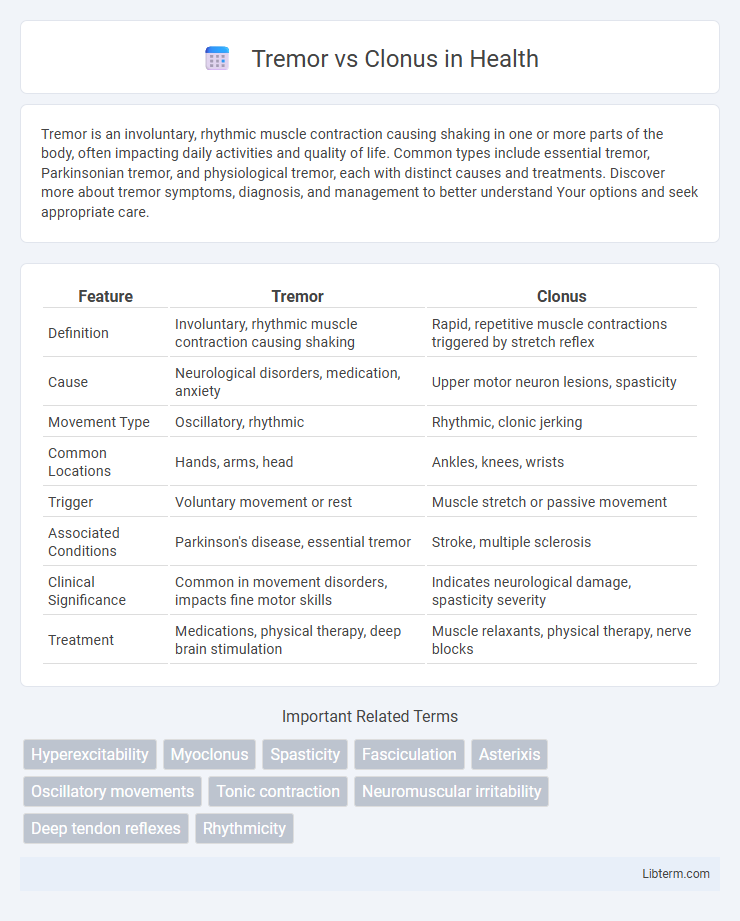Tremor is an involuntary, rhythmic muscle contraction causing shaking in one or more parts of the body, often impacting daily activities and quality of life. Common types include essential tremor, Parkinsonian tremor, and physiological tremor, each with distinct causes and treatments. Discover more about tremor symptoms, diagnosis, and management to better understand Your options and seek appropriate care.
Table of Comparison
| Feature | Tremor | Clonus |
|---|---|---|
| Definition | Involuntary, rhythmic muscle contraction causing shaking | Rapid, repetitive muscle contractions triggered by stretch reflex |
| Cause | Neurological disorders, medication, anxiety | Upper motor neuron lesions, spasticity |
| Movement Type | Oscillatory, rhythmic | Rhythmic, clonic jerking |
| Common Locations | Hands, arms, head | Ankles, knees, wrists |
| Trigger | Voluntary movement or rest | Muscle stretch or passive movement |
| Associated Conditions | Parkinson's disease, essential tremor | Stroke, multiple sclerosis |
| Clinical Significance | Common in movement disorders, impacts fine motor skills | Indicates neurological damage, spasticity severity |
| Treatment | Medications, physical therapy, deep brain stimulation | Muscle relaxants, physical therapy, nerve blocks |
Understanding Tremor: Definition and Causes
Tremor is an involuntary, rhythmic muscle contraction causing shaking movements in one or more parts of the body, commonly observed in conditions such as Parkinson's disease, essential tremor, and multiple sclerosis. It results from abnormal activity in brain regions like the cerebellum, basal ganglia, or thalamus, often triggered by neurological disorders, medication side effects, or metabolic imbalances. Differentiating tremor from clonus, which involves rapid, rhythmic muscle contractions due to hyperactive reflexes, is crucial for accurate diagnosis and treatment.
What is Clonus? Key Features and Mechanisms
Clonus is a neurological condition characterized by involuntary, rhythmic muscle contractions and relaxations, typically caused by sudden stretching of a muscle. Key features include repeated, rhythmic jerking movements often observed in the ankle or wrist, resulting from hyperactive stretch reflexes due to upper motor neuron lesions. The underlying mechanism involves exaggerated spinal cord reflex arcs and impaired descending inhibitory signals, leading to sustained muscle contractions and rapid oscillations in muscle length.
Clinical Differences Between Tremor and Clonus
Tremor is characterized by rhythmic, involuntary muscle contractions causing shaking movements, commonly seen in conditions like Parkinson's disease and essential tremor, typically affecting distal limbs symmetrically. Clonus involves rapid, repeated muscle contractions and relaxations triggered by sudden stretch, often indicative of upper motor neuron lesions such as spinal cord injury or stroke, presenting as rhythmic jerking primarily in the ankle or wrist. Clinically, tremor is spontaneous and varies with posture or movement, whereas clonus is an elicited reflex with sustained repetitive beats upon passive stretch.
Types of Tremor: Essential, Resting, and More
Tremor is classified into several types, including Essential Tremor, characterized by rhythmic shaking during voluntary movements, and Resting Tremor, which occurs when muscles are at rest and is commonly associated with Parkinson's disease. Other types include Intention Tremor, seen during purposeful movement, and Physiological Tremor, a subtle shake present in all individuals. Clonus differs by presenting as involuntary, rhythmic muscle contractions typically triggered by sudden stretch, often linked to neurological conditions like spinal cord injury or multiple sclerosis.
Clonus: Triggers and Associated Neurological Conditions
Clonus is characterized by rhythmic, involuntary muscle contractions often triggered by sudden stretch or stimuli, frequently observed in patients with upper motor neuron lesions. Common neurological conditions associated with clonus include multiple sclerosis, stroke, spinal cord injury, and cerebral palsy. The presence of clonus typically indicates disrupted inhibitory pathways within the central nervous system, contributing to hyperactive reflex responses.
Diagnostic Criteria: How to Identify Tremor vs Clonus
Tremor is characterized by rhythmic, oscillatory movements affecting specific muscles, typically evaluated through clinical observation and electromyography to assess frequency and amplitude. Clonus presents as repetitive, involuntary muscular contractions triggered by sudden muscle stretch, identified by eliciting rapid dorsiflexion or plantarflexion and observing rhythmic muscle spasms. Distinguishing tremor from clonus relies on examining movement patterns, response to voluntary control, and specific elicitation maneuvers during neurological examination.
Underlying Pathophysiology: Tremor vs Clonus
Tremor arises from rhythmic oscillatory movements caused by dysfunction in the cerebellum, basal ganglia, or peripheral nerves affecting motor pathways. Clonus results from hyperactive stretch reflexes due to upper motor neuron lesions, leading to repetitive muscle contractions triggered by sudden muscle stretch. The distinct pathophysiological basis differentiates tremor's central or peripheral origin from clonus' spinal reflex hyperexcitability mechanisms.
Common Symptoms and Patient Presentation
Tremor typically presents as rhythmic, involuntary shaking most noticeable in the hands, arms, or head during voluntary movements or at rest, often worsening with stress or fatigue. Clonus is characterized by rapid, repetitive muscle contractions and relaxations, primarily triggered by sudden muscle stretching, leading to jerking movements commonly seen in conditions affecting the central nervous system. Patients with tremor may report difficulty with fine motor tasks such as writing, while those with clonus often experience muscle stiffness and spasms associated with neurological disorders like multiple sclerosis or spinal cord injury.
Treatment Approaches for Tremor and Clonus
Treatment approaches for tremor commonly include beta-blockers such as propranolol, anticonvulsants like primidone, and physical therapy to improve motor control. Clonus management primarily focuses on muscle relaxants such as baclofen, tizanidine, and benzodiazepines that reduce hyperactive reflexes. Botulinum toxin injections and neuromodulation techniques like deep brain stimulation are emerging options for refractory cases of both tremor and clonus.
Prognosis and Long-Term Management Strategies
Tremor and clonus, both indicative of neurological dysfunction, differ in prognosis and long-term management based on underlying etiology. Tremor prognosis varies, improving with medication like beta-blockers or deep brain stimulation for essential tremor, while clonus often signals upper motor neuron lesions requiring spasticity management through physical therapy, antispastic drugs, or neuromodulation. Long-term strategies for both emphasize individualized multidisciplinary approaches including pharmacologic treatment, rehabilitative exercises, and regular neurologic evaluation to optimize functional outcomes and quality of life.
Tremor Infographic

 libterm.com
libterm.com